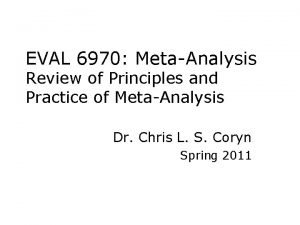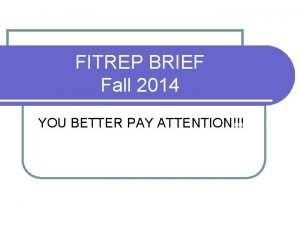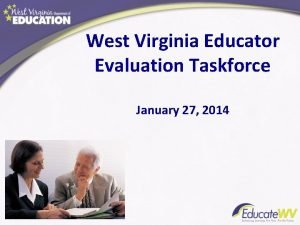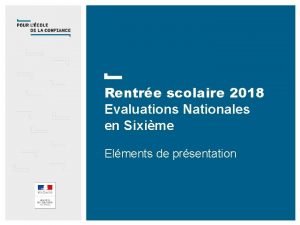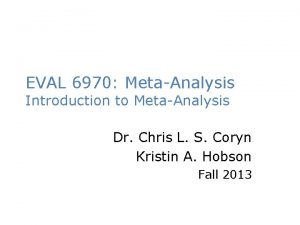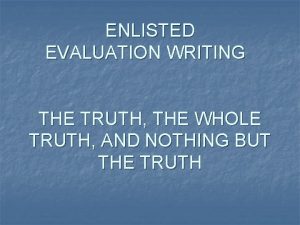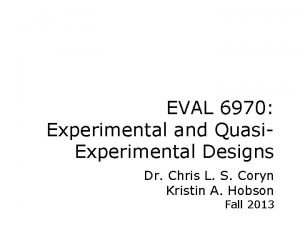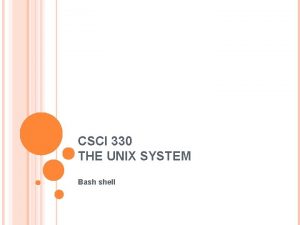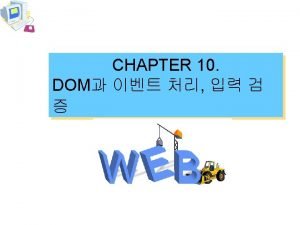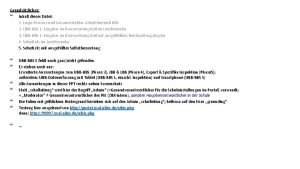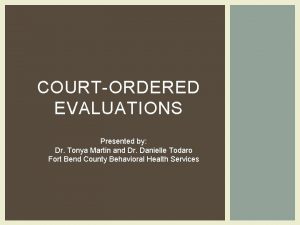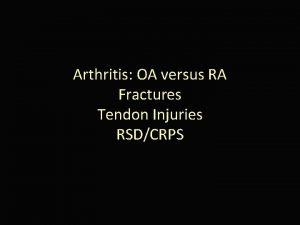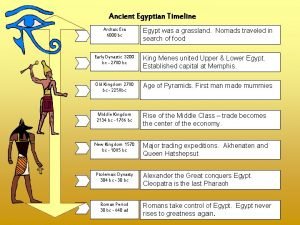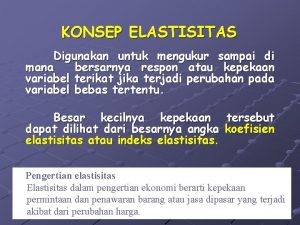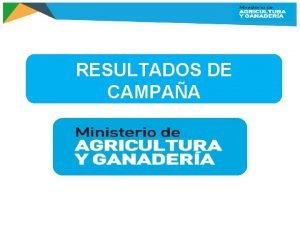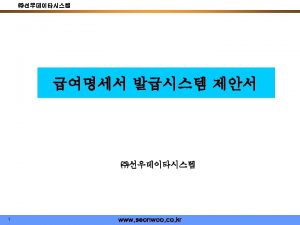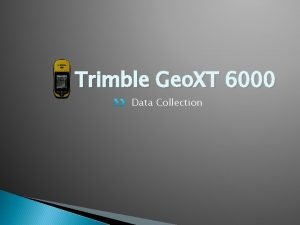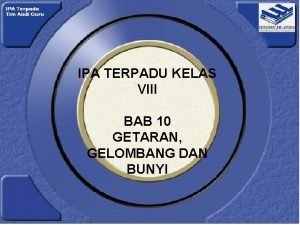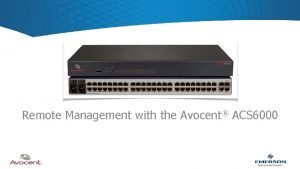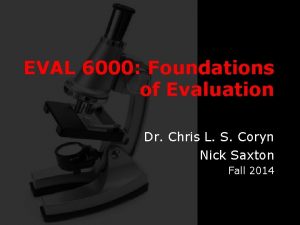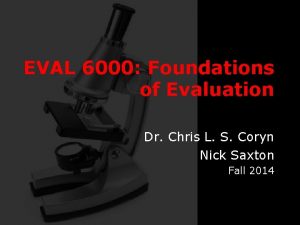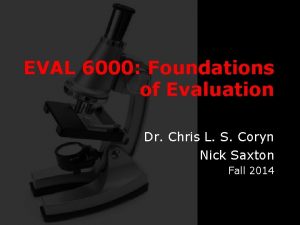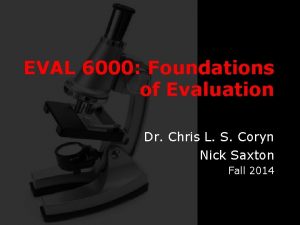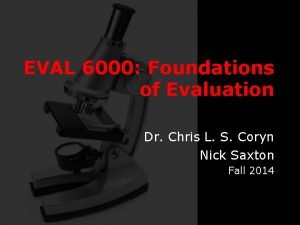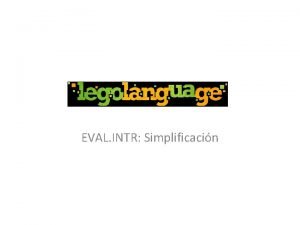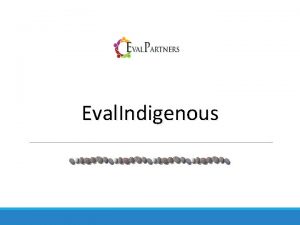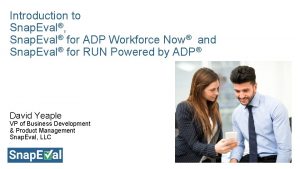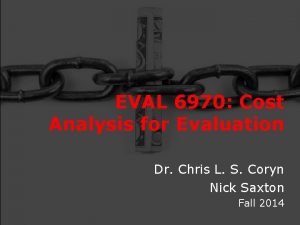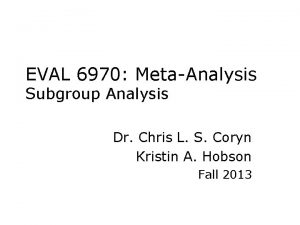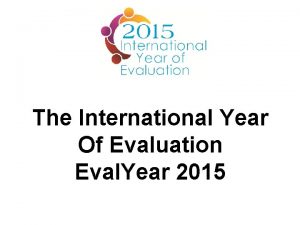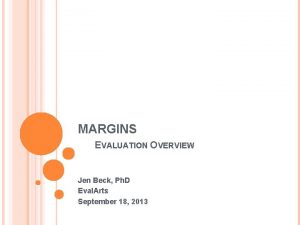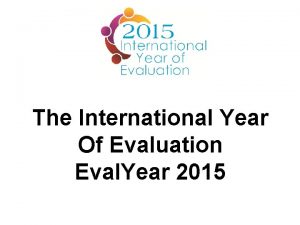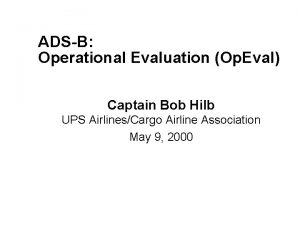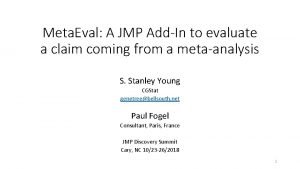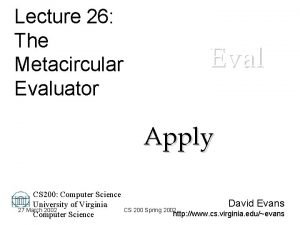EVAL 6000 Foundations of Evaluation Dr Chris L





























- Slides: 29

EVAL 6000: Foundations of Evaluation Dr. Chris L. S. Coryn Nick Saxton Fall 2014

Agenda • Quasi-evaluation studies • Activity (if time allows)

Quasi-evaluation studies

Quasi-evaluation studies • Address specific questions (often employing a wide range of methods) • Advocate use a particular method • Whether the questions or methods are appropriate for assessing merit and worth is a secondary consideration • Both are narrow in scope and often deliver less than a full assessment of merit and worth

Approach 7: Objectives-based studies • Advance organizers – Statement of program objectives • Purposes – To determine to what extent a program achieved objectives • Sources of questions – Objectives as defined by staff, funder, or evaluator • Questions – To what extent were each of the stated objectives met?

Objectives-based evaluation results from a national research center

• Methods – Any relevant method for determining to which operationally defined objectives were met • Pioneers – Ralph Tyler • Use considerations – Must have clear, supportable objectives • Strengths – Ease of application • Weaknesses – Narrowness and inability to identify positive and negative side effects

Approach 7: The success case method • Advance organizers – Comparison between successful and unsuccessful instances • Purposes – To determine how well and in what respects a program is ‘working’ • Sources of questions – Generally from program providers • Questions – What are the noteworthy successes? – How were successes produced? – What factors contributed to success/failure?


• Methods 1. 2. 3. 4. Focus and plan the study Create an impact model Survey all participants Interview a sample of success and nonsuccess cases 5. Communicate findings, conclusions, and recommendations • Pioneers – Robert Brinkerhoff • Use considerations – Intended to assist service providers in increasing ‘successes’ and decreasing ‘nonsuccesses’ • Strengths – Ease of application – Use for improvement • Weaknesses – Narrowness of scope

Approach 9: Outcome evaluation as value-added assessment • Advance organizers – System-wide measures of ‘growth’ or ‘gains’ • Purposes – ‘Value added’ by a program and its constituent parts • Sources of questions – Oversight bodies • Questions – What parts of a program contribute most to ‘growth’ or ‘gains’?

• Methods – Gain score analysis, hierarchical linear modeling, etc. • Pioneers – Raudenbush, Sanders, Horn, Timms, etc. • Use considerations – Can be used to make and/or support policy decisions • Strengths – Longitudinal rather than cross-sectional • Weaknesses – Potential misuse by policy makers in placing ‘blame’

Approach 10: Experimental and quasi-experimental studies • Advance organizers – Cause-and-effect hypotheses, competing treatments, etc. • Purposes – To determine causal relationships between independent and dependent variables • Sources of questions – Researchers, developers, policy makers, etc. • Questions – To what extent is one treatment superior to another?


• Methods – Random or other method of assignment to conditions • Pioneers – Campbell, Cook, Shadish • Use considerations – Addresses only one particular type of question • Strengths – Strong causal conclusions (if assumptions are met) • Weaknesses – Requires substantial expertise, time, money, etc.

Approach 11: Cost studies • Advance organizers – Costs associated with program inputs, outputs, and outcomes • Purposes – The costs and outcomes of one more alternatives • Sources of questions – Policy makers, planners, taxpayers, etc. • Questions – What are the costs of obtaining desired outcomes?

• Methods – Analysis of monetary and nonmonetary units • Pioneers – Levin, Mc. Ewin, Yates, etc. • Use considerations – Expertise required • Strengths – ‘Bottom line’ conclusions of interest to most decision makers • Weaknesses – Often difficult to validly execute

Approach 12: Connoisseurship and criticism • Advance organizers – Specialized expertise, sensitivities, tacit knowledge, etc. • Purposes – To describe, appraise, and illuminate • Sources of questions – Determined by the ‘connoisseurs’ or ‘critics’ • Questions – What are a program’s salient characteristics, strengths, and weaknesses?

• Methods – Perceptual sensitivity, prior experience, refined insights, etc. • Pioneers – Elliot Eisner • Use considerations – An audience willing to accept the approach • Strengths – Exploitation of refined expertise • Weaknesses – Objectivity and reliability

Approach 13: Theory-based evaluation • Advance organizers – A carefully specified ‘theory’ of how a program is intended to operate • Purposes – To determine the extent to which a program is ‘theoretically sound’ • Sources of questions – Determined by the guiding program theory • Questions – To what extent does the program theory ‘work’ or not?



• Methods – Any method appropriate for testing the program theory • Pioneers – Chen, Donaldson, Weiss, Rogers, Rossi, etc. • Use considerations – Difficulty in applying the approach • Strengths – Useful for determining potential ‘measurement’ variables • Weaknesses – Few programs are grounded by validated ‘theories’

Approach 14: Meta-analysis • Advance organizers – Sufficient studies of the same or similar programs • Purposes – To assemble and (statistically) integrate findings from multiple studies of the same or similar programs • Sources of questions – Policy makers, ‘research repositories’, etc. • Questions – What is the average effect of a particular type of program?


• Methods – Statistical methods for integrating study results (varies widely) • Pioneers – Glass • Use considerations – Major source of contemporary ‘best practices’ across a variety of domains • Strengths – Evidence of effectiveness over units, treatments, observations, and settings • Weaknesses – Exclusive emphasis on program outcomes

Activity

Activity • We will split the class into two sections (1 and 2) – In each section, appoint one student to chair your appointed group – Each member of section 1 should select one of the approaches discussed today and discuss why it is useful – Members of section 2 should listen and take notes – Members of section 2 should then outline weaknesses of the selected approaches – Finally, the chair of each group should discuss the potential strengths, weaknesses, and utility of the selected approaches

Encyclopedia Entries • • • Bias Causation Checklists Chelimsky, Eleanor Conflict of Interest Countenance Model of Evaluation Critical Theory Evaluation Effectiveness Efficiency Empiricism Independence • Evaluability Assessment • Evaluation Use • Fournier, Deborah • Positivism • Relativism • Responsive evaluation • Stake, Robert • Thick Description • Utilization of Evaluation • Weiss, Carol • Wholey, Joseph
 Dr eval
Dr eval Navy fitrep block 41 examples
Navy fitrep block 41 examples Wveis ed eval
Wveis ed eval Eval.dep.taocloud
Eval.dep.taocloud Dr eval
Dr eval Navy eval closing statement
Navy eval closing statement Block 40 chief eval
Block 40 chief eval Qualit eval
Qualit eval Dr eval
Dr eval Eval command
Eval command Navigator.getinstalledrelatedapps
Navigator.getinstalledrelatedapps Bbs eval nibis
Bbs eval nibis Tonya eval
Tonya eval Initial eval
Initial eval 6000 bce egypt
6000 bce egypt Turunnya harga bensin dari 6000 menjadi 5000
Turunnya harga bensin dari 6000 menjadi 5000 John's parents deposited $1000
John's parents deposited $1000 Sathya deposited rs 6000
Sathya deposited rs 6000 4000000/3500
4000000/3500 Nfpp in motor insurance
Nfpp in motor insurance Mf 6000 series
Mf 6000 series Polycom qdx 6000
Polycom qdx 6000 Benchmill 6000
Benchmill 6000 Geo 6000
Geo 6000 Periode getaran adalah
Periode getaran adalah Avocent acs 6000
Avocent acs 6000 Camping equipment weighing 6000 n
Camping equipment weighing 6000 n Paraqueima de 6 a 10
Paraqueima de 6 a 10 6000-5781
6000-5781 Karanovo
Karanovo
